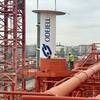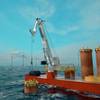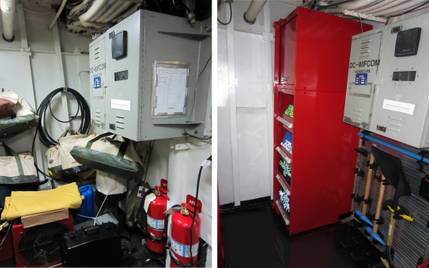Rolls-Royce Introduces New Technology
“Water flow through the unit is unobstructed since there is no gearbox in the tunnel, nor are struts needed to support a hub. Propeller blades are attached to the rim, eliminating uncontrolled flow between blades and tunnel. The permanent magnet motor design is very efficient. Together these factors give a high total efficiency and reduced noise and vibration. Because more thrust is produced for a given power input, fuel consumption is reduced, and this saving can be substantial in applications such as offshore support vessels operating in dynamic positioning (DP) mode where thrusters may run for hundreds or thousands of hours a year. Fuel saving is not only a matter of money; the impact of the vessel on the environment is also reduced. “The Rim Thruster is designed to be mountable and dismountable under water, so that it can be removed for servicing if required without drydocking the vessel. We use water-lubricated bearings, eliminating propeller shaft seals and oil-filled gear housings. “The motor is an integral part of the unit in the tunnel, so the ship designer no longer has to find space for a bulky electric motor in a thruster room. The only parts of the thruster inside the hull are the cables connecting it to the frequency control supply cabinet. The cabinet is similar to that used with any frequency controlled electrically driven thruster, and its location is flexible.”
Olympic Shipping, based in Fosnavåg in Norway, has ordered the first RT1600 for their UT 712 CD anchor handler now under construction at Aker Yards Søviknes. This vessel will have twin CP propellers for main propulsion, and other thrusters to give the station keeping power needed to meet IMO DP2 dynamic positioning standard. The rim drive unit will be installed in the aft skeg acting as a stern side thruster. Helge Gjerde, President-Offshore Propulsion in Rolls-Royce said, “We are delighted that Olympic Shipping is fitting the new thruster type to their latest vessel. As equipment manufacturers we are dependent on forward thinking shipowners to bring new products and systems to market. Olympic’s UT 712L is also the first to fit Rolls-Royce’s newly developed DP2 dynamic positioning system, and also the equipment for making work on deck safer.” Bjørn Kvalsund, operations director of Olympic Shipping, makes the point that, “Our background in fishing and offshore has shown us that good equipment is the key to success, and that investment in technology that increases efficiency pays off in the long term. We aim to provide our oil company customers with vessels suited to their present and future needs, not their past ones, and to offer fuel efficient vessels with low environmental impact. The safety and well-being of our crews is just as important, and equipment that produces less noise and vibration is a valuable contribution to this.”












